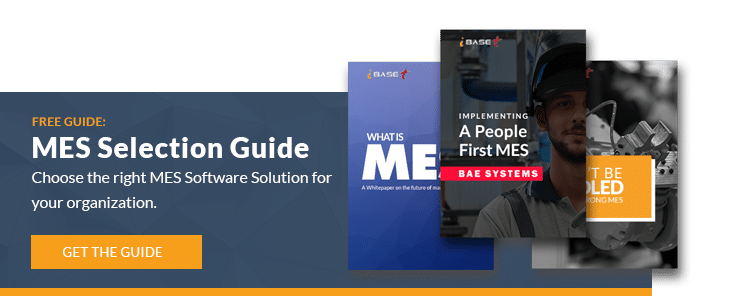
On Wednesday, April 29th, 2020, iBase-t hosted a webcast that presented a compelling case to evaluate if you are still running a legacy Manufacturing Execution System (MES). Now might be an ideal time to start the replacement process. Given the recent changes that COVID-19 has had on global demand, operations, and business models, the importance of having clear visibility and strong control over how operations are managed or changed is now a hot issue.
Watch a recording of this webinar here.
Legacy, monolithic MES applications are dinosaurs. Take a moment today to position your MES for the next decade, to avoid having to do this again. New agile MES strategies now exist whereby new features, upgrades, and improved performance power can be added as needed, when needed, without a full rip-and-replace. And, even more importantly, a modern MES is capable of being managed and supported remotely (by reduced staff) while being capable of rolling out new capabilities and deploying advanced technologies (AI, mobile, cloud, advanced analytics, IIoT).
During and after the original presentation of this webcast, several questions were raised by those in attendance. We thought it would be helpful and worthwhile to share that feedback as additional information that can be used as part of your assessment to embark on this type of project today.
Question #1: This is a topic we face with not only our MES but also other enterprise solutions (PLM, ERP, CRM, QMS, etc.) – what do you think is specific to MES in the approach described in this presentation to identify/replace the MES dinosaur?
With a Manufacturing Execution System, the user base is quite specific. An MES will likely be the only enterprise system used by most individuals on the shop floor. In addition, companies do not have the luxury for multi-year rollouts on the shop floor where they may have that opportunity more so in the PLM and ERP selections. Of course, many of these principles are applicable to other enterprise choices, however, only the MES system has the same level of impact on the most users, has the most risk, and has the largest need to be innovative. The effectiveness of an MES has a very direct impact on product and company innovation will hit on the shop floor. While sometimes manufacturing companies consider themselves to be more of an engineering firm, they still make their profit by manufacturing and selling their products for the price that will give them the highest profit margins. Investing in modernizing an MES will have a far greater impact on future profitability than any other enterprise system.
Question #2: How do you take into consideration data feeds and integration points with other enterprise platforms which feed MES during this type of migration?
When starting an evaluation to replace a legacy MES, everything starts with mapping and understanding not only the data that needs to be shared by each system, but also how each system uses the information. A great example of this is a Bill of Material (BOM). Your Product Lifecycle Management (PLM) solution needs a BOM to support product configuration (engineering BOM), while your Enterprise Resource Planning (ERP) system needs a BOM for financial and scheduling reasons (planning BOM). Your MES needs the BOM to understand what parts will be validated during a build (operations BOM). All systems leverage the same type of information, but they digest and use it differently. That said, data feeds and integration points must be flexible and interchangeable – a key performance improvement enabler of implementing a modern MES system, readily enabled with an open structure using a standard Application Programming Interface (API) that facilitates the transference of this information to and from each enterprise system. Open architecture and an open standards architecture with platform-agnostic capabilities lead to the ability to quickly integrate, update, and maintain on a go-forward basis.
Question #3: Are more MES deployments going to the cloud?
The use of cloud technologies in manufacturing operations is a trend that has been in play for the past decade. While it is unlikely all operations will ever go to the public cloud, private and hybrid cloud offerings have become increasingly popular over the past few years. Gartner’s research confirms, as referenced in a recent report, that there is movement, albeit at a glacial pace. The emergence of COVID-19, however, will likely have an impact on future plans. The value of supporting remote work, implementations, and performance modifications will likely speed up any cloud migration strategies. The benefits are obvious. Regardless of where you are in your cloud migration journey, picking an MES that has the ability to run in any environment has quickly become a “must-have” technical requirement, part of what can be accomplished with modern, agile applications.

